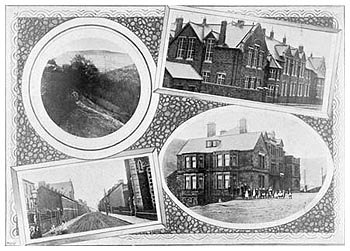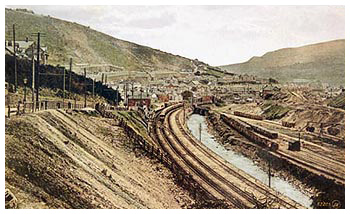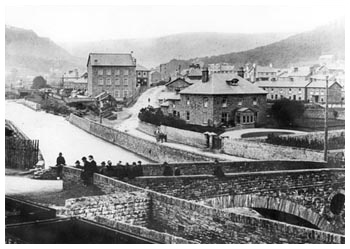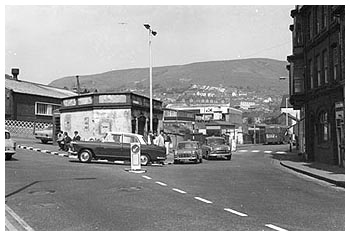
| Porth & Cymmer | |
| Porth known as 'The gateway to the Rhondda' derives its name from its position at the entrance to the two Rhondda Valleys, the Rhondda Fach and The Rhondda Fawr. Similarly Cymmer, which is now seen as a 'suburb' of Porth, derives its name from the old Welsh word that describes a spot where two rivers of the same name converge. Early sources show that originally the positions were reversed and that the district was more commonly known as Cymmer. It was only with the development of the mining operations on the Porth Estate, and the coming of the Taff Vale Railway to Porth, that the name Porth for the area came to prominence. | |
| In common with most of the Rhondda, prior to the emergence of coal mining Porth was very much a 'rural idyll', sparsely populated and of great natural beauty. Porth however was one of the first districts within the Rhondda to see industrialisation on a large scale, changing its nature from one of pastoral tranquillity to one that that 'assumed the dreary, God-forsaken aspects of colliery districts in general'. Prior to its development in Porth mining on any scale, in the Rhondda, had only been undertaken at Dinas. However major development really began with the penetration of the Taff Vale Railway into the area alongside an upsurge in demand for coal leading to a shortage in supplies. |
Porth circa 1900 |
Cymmer Bridge |
This coupled with improved mining techniques meant that conditions were ripe for the development of the industry within the Rhondda Valleys. This attracted mining speculators to the area, and the one of most significance to the development of Porth was George Insole. Insole was the owner of a shipping company in Cardiff that had specialised in coal. Seeing an increasing demand for bituminous coal he decided to become a producer rather than just a supplier. To this end he opened Maesmawr Colliery, but production was lower than he had hoped. Also the coal produced was of inferior quality to 'Coffin's Coal' as that produced at Dinas had become known. |
| Thus in 1844 he leased the mineral rights to 375 acres of land at Cymmer from Evan Morgan of Tyn-Y-Cymmer Farm, opening the South Cymmer Level in the December of the year. At first progress was slow and output, from the No.2 Rhondda seam, disappointing. Thus Insole decided in 1847 to sink a pit, the No.1 Pit or Old Cymmer Pit, to the No.3 Rhondda. Seam. This was struck some eighty yards below the No.2 seam and quickly gained a reputation as a coking coal, an in 1848 36 coke ovens were constructed at Cymmer. To meet ever increasing demand the operations at Cymmer were extended and in 1851 the Upper Cymmer Colliery was sunk. Also in 1855 the New Cymmer Colliery was opened near the Cymmer Old Pit. Thus began the mining industry in the Rhondda, which was to dominate the landscape and lives of the people of the Valley for the next hundred and fifty years. |
|
| THE CYMMER COLLIERY EXPLOSION 1856 | |
| On the morning of Tuesday 15th July 1856 at the 'Old Pit' in Cymmer, there occurred as stated in the Mines Inspector's report, 'The most fearful and destructive explosion, resulting in a sacrifice of human life unparalleled in the history of Britain at that time'. At 6.00 a.m. one hundred and sixty men and boys descended the shaft to begin their shift and were on their way to their working places when the explosion took place. The ferocity of the explosion led rescuers to believe that all lives below ground would be lost. However some miners had only descended a short way into the pit and were able to make their way back to the shaft and safety. Rescuers took measures to clear the mine of afterdamp, and descended into the mine some three hours after the initial explosion took place. By that Tuesday evening some 112 bodies had been brought to the surface of the mine, another was recovered on the Wednesday and one severe burns victim died on the Thursday. At the pithead relatives and friends searched to identify victims, few of whom were not badly burnt, dying instead of suffocation caused by the afterdamp. Temporary mortuaries were set up in the Colliery's carpenters shop and also Cymmer Independent Chapel. The scale of the disaster devastated the small communities of Cymmer and surrounding areas, with no household left untouched and virtually all working age men and boys having perished. One household alone saw a father and his three sons aged 10, 13, and 16 all perish. Thirty graves were opened at Cymmer Independent Chapel's graveyard, and a mass internment of victims took place on Thursday 17th July. The first inquest into the disaster was held at the Ty Newydd Hotel, Porth on the 16th July, which was subsequently adjourned until Monday 27th July at the Butchers Arms in Pontypridd. The inquest lasted 13 days and twenty-nine witnesses were called. At the inquest it became clear that safety precautions at the colliery were woefully inadequate, and mines safety regulations were ignored. It was seen that the mine was poorly ventilated, and that pockets of gas were an everyday feature of life below ground, additionally the carrying of naked flames in the mine was commonplace. The jury returned a verdict of manslaughter on the colliery manager, Jabez Thomas, and four senior officials at the mine. This verdict was overturned at the Glamorgan assizes at Swansea, the following March, leading to a great deal of resentment among colliery workers. |
|
| DISASTER AT TYNEWYDD COLLIERY PORTH APRIL 1877 | |
| On the 11th April 1877, at about 4p.m.., the Tynewydd pit of the Troedyrhiw colliery became inundated with water. At the time of the disaster the pit employed about 100 men, but when the accident occurred only 14 men were underground. The accident was caused by a breakthrough from the mine's workings through to the abandoned, and flooded, workings of the old Cymmer Pit. Immediately rescue attempts were begun to find the fourteen missing miners. Five survivors were found when a knocking was heard, and rescuers cutting through a 12 yards thick pillar of coal reached them the following morning. Unfortunately the force of compressed air released when the first small hole was cut to the pocket where the man were, led to one of the survivors (William Morgan) being crushed to death. It was assumed that the remaining nine men had been drowned in the flooded mine. However further knocking was heard coming from the stall of Thomas Morgan, which was below the level of the floodwater, leading rescuers to assume that some survivors had been trapped in an air pocket. An unusual rescue attempt using two divers from London was attempted, but the amount of debris in the mine made it impossible. As such the only means of reaching the trapped miners was to cut through over 38 yards of coal. Working day and night it took the rescuers ten days to reach the five trapped men, during which time the plight of the miners captured the attention of the world's press with even Queen Victoria sending telegrams asking for the latest news. At 2.30 p.m. on Friday April 20th the rescue team finally reached the five trapped men, who had been without food and had only the filthy flood waters to drink for ten days. The miners were all found to be suffering from 'the bends' due to rapid decompression and spent eighteen days in hospital, but otherwise made full recoveries from their ordeal. Four other miners missing after the flooding had drowned in the workings. Afterwards Queen Victoria awarded twenty-four first and second class Albert medals to the rescuers. | |
| The beginings of education in Porth | |
| Education, alongside religion, has traditionally, played a major role in the lives of the people of the Rhondda. Among working people it was seen as a 'way out of the pit' and the route to a better life for your children than the life yourself had. However to keep your children in school was a sacrifice, in times when money and work was scarce another breadwinner was often essential, and when work was plentiful the lure of another wage to large working class households was similarly tempting. Despite this the Rhondda became famed for its attitude to education and self-improvement. |  |
| However up until 1859 the only educational facilities in the Porth area, in the main, belonged to the Sunday Schools. Then in 1859 the National Society opened the Cymmer National School for the purposes of, 'inculcating Church of England doctrines in addition to the usual secular subjects'. Soon after a 'British School' was opened at Porth for those whose parents objected to Church of England doctrines. This was held for many years at Bethlehem Chapel, eventually becoming Porth Boys School. Changes in the law meant that attendance at school became compulsory and School Boards came into existence in order to raise money from local rates and supply school accommodation. Thus in the late 1870's Cymmer National school was transferred to the Llantrisant School Board, and Porth British School to that of Llanwonno. However the rapid growth of the area meant that more new schools were needed, thus a new school was built at Cymmer and opened in 1881. Eventually in the 1890's all schools in the Porth area came under the newly formed Ystradyfodwg School Board. The old National School at Cymmer became a Pupil Teacher's Centre for the training of aspiring student teachers in 1893, operating on a part time basis. This itself was incorporated into the new secondary school buildings. Following the Welsh Intermediate Schools Act of 1889, The Rhondda Intermediate School was built at Porth, where both boys and girls received advanced education 'fitting them to take degree courses at any university'. This was built on three acres of land above Mount Pleasant given free by Colonel Picton Turberville and was opened on September 22nd 1896, later evolving into Porth County School. In 1913 the Girl's County School was opened. Later on the School Board established a Higher Elementary School at Mount Pleasant, which was raised to the status of a Secondary school in the late 1920s. The Higher Grade schools were limited in function, being seen as providing for the son of the miner vocationally oriented training. However the Intermediate School was expected to cater for the fee paying middle class minority as well as those gifted enough to receive scholarships, and had a more varied classically based syllabus. Also within Porth were two private schools that flourished for a number of years in the early twentieth century, the Cambrian Mining School and the Commercial School both based in Cemetery Road. Finally in the Tynycymmer Hall was set up The South Wales Bible Institute where men and women were trained 'in Bible knowledge...for all kinds of Christian work at home and abroad'. |
|
| Early religious history of Porth | |
| Religion in general and non-conformity in particular is synonymous with the Rhondda, and the religious and social importance of 'the chapel' cannot be overstated. The development of the villages of the Rhondda followed a familiar pattern upon the opening of a local mine, and the influx of workers to an area. Invariably the religious needs of this burgeoning community were one of the first to be met. Thus in Porth at the end of the nineteenth century, the residents had a large number of options in terms of sects and places of worship, some of which are detailed below:
The Primitive Methodists The English Congregationalists. The Welsh Wesleyans The Welsh Baptists The Tabernacle, Porth - English Baptist The Welsh Congregationalists Pugh Memorial Church The English Wesleyan Church The Church in Wales |
|
| Thomas and Evans | |
| The name Thomas and Evans and the Welsh Hill Works, and subsequently Corona pop are synonymous with the town of Porth. This business was primarily the driving force of one man, William Evans businessman and philanthropist. He was born near Fishguard in 1864, one of fourteen children. After successfully completing his apprenticeship to a grocer in Haverfordwest, he worked for Alderman William Thomas as a junior in his grocery stores. Then at the age of nineteen, in 1883, he became manager of the Porth branch of Peglar's Stores. Two years later William Evans, with the financial assistance of Alderman Thomas set up his first provision store named Thomas and Evans in Hannah Street Porth |
Porth Square with the Corona factory in the background
|
| In 1888 at the age of twenty-four, William Evans had paid back, with profits, Alderman Thomas' investment, and was in business for himself for the first time. By 1895 he had expanded, owning four grocery stores and had been joined in the enterprise by his brother Frank. It was when from his factory in Porth, under the name of Welsh Hill Mineral Waters, he began to manufacture his hop bitters, ginger beer and lemonade his fortune and fame really took off. These proved so popular that William Evans was forced to open factories all over South Wales to cater for the demand. In the early 1920's the brand was changed to that of Corona, and the business saw an expansion that saw Corona pop 'exported' all over Britain. Eventually eighty-seven factories and depots were opened throughout England and Wales, including in 1934 one in Willesden, London. After Williams' death in 1934, his brother Frank continued this expansion opening up a number of overseas markets. After periods of being owned by both Beechams and Britvic, the company finally closed the doors of its Porth factory for the last time in September 1987. The legacy of William Evans is still to be seen today in Porth, chiefly in Bronwydd Park, and also the Public Library both of which he gave to the people of Porth. |
|


